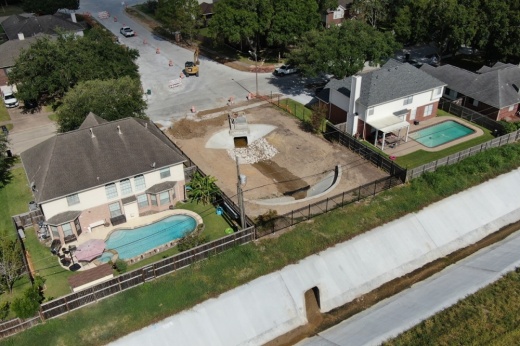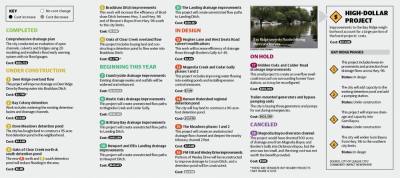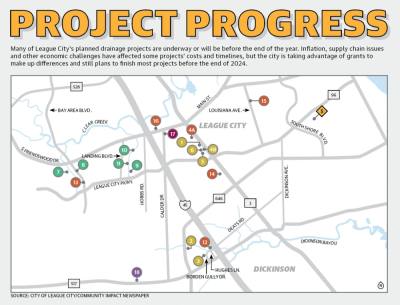The $145 million bond voters approved in May 2019 included 21 local drainage projects totaling $73 million to address Harvey-affected areas. City officials have spent the past three years designing, engineering and gathering necessary permits and land for the projects, but now residents can see work is underway.
City leaders said they are happy to see progress and hope to complete most of the projects before the end of 2024.
“You can see the measurable difference from a year ago,” City Manager John Baumgartner said.
Of the 21 projects and their various subprojects, one has been completed; nine are in progress; and six will begin construction before the end of the year. Another seven are under design; one is on hold; and another project was nixed due to rising costs, Director of Engineering Chris Sims said.
Other projects also are increasing in cost and seeing delayed timelines due to inflation and supply chain shortages due to COVID-19.
Kathy Garland, a professor of environmental management at the University of Houston-Clear Lake, said she cannot imagine heading up drainage or similar projects with so many issues outside a city’s control, such as delays in materials shipping and rising costs.
“It must be so frustrating,” she said.
In addition, there are a few local drainage projects outside the bond’s scope that are also making progress, and city officials said another bond may go before voters in the next few years for additional projects.
Making progress
One of the most expensive neighborhood projects underway is in the Bay Ridge neighborhood, which was hit particularly hard by Harvey in August 2017.
Dave Bowman, a retired civil engineer and Bay Ridge resident of over 40 years, said over 90% of Bay Ridge’s homes flooded. During the storm, he took a raft around the neighborhood to survey the damage.
“It was pretty bad everywhere,” he said.
Phase 3 of the $20.36 million four-phase project is scheduled for completion in early fall and includes rebuilding and adding capacity to portions of the neighborhood’s storm sewer system to reduce the ponding of water in streets during storms, according to city documents.
The old storm sewers were undersized, resulting in flooding during storms that leaves residents with flooded driveways and unable to drive out of the neighborhood. The new storm sewers are over twice as big, Bowman said.
“By design, we should flow to the pond with much more ease as long as we keep our ... basins clear,” he said.
Phase 2 of Bay Ridge began this summer and includes increasing the depth of the neighborhood’s existing detention pond by 6 feet. This will give the pond more capacity to handle the additional stormwater the large sewer system sends its way, Bowman said.
A stormwater pump station will be installed as well to pump water from the pond into Gum Bayou, which feeds into Clear Creek, which is how the water gets out of the neighborhood, Sims said.
Bay Ridge Phase 1 is expected to begin this year. The work will include improvements and protection from drainage flows across Hwy. 96, according to city documents.
Bowman said there has not been enough rain to fully test the upgrades the neighborhood has received so far. While the upgrades would probably not withstand another Harvey, Bowman is confident they will make a difference for most storms.
“We just haven’t had enough rain to prove anything, but on paper, we’re significantly better,” he said. “I think we’re significantly better than we will have been ever in the past.”
Another project underway is in the Oaks of Clear Creek neighborhood and set to finish in late summer. The $3.77 million project will route stormwater from neighborhood roads into Bradshaw Ditch.
Additionally, construction is underway on a southern detention pond aimed at retaining more water in the neighborhood; the northern detention pond planned for the area is still under design, Sims said.
Contractors are almost done making overland flow improvements to Deer Ridge Drive to improve drainage to Bradshaw Ditch, Sims said.
Other improvements to Bradshaw Ditch, which runs between Hwy. 3 and Hwy. 96 in the neighborhood, and Benson’s Bayou from Hwy. 96 to the southern city limit are also underway.
“It should be a quick project,” Executive Director of Capital Projects Ron Bavarian said.
Meanwhile, the city is adding capacity to 18 existing detention ponds within the Bay Colony area. Dove Meadows is a separate neighborhood that will see relief beginning in September when contractors begin constructing a 115-acre-foot detention pond on the east side of the area, Bavarian said.
The Countryside subdivision improvements include constructing ditches to convey stormwater toward outlets. This project is ready to go to bid, he said.
A project in the Rustic Oaks neighborhood is still under design, but construction is expected to begin this year, Sims said. The $330,245 project will include creating ditches to flow water to Magnolia Creek and Cedar Gully.
Three separate projects to create ditches to direct water to nearby channels in the Brittany Bay, Landing, and Newport and Ellis Landing subdivisions are expected to go to bid late this year.
In June 2021, League City finished using 2D modeling to evaluate the city’s channels and culverts and installed six flood gauges. This comprehensive drainage plan helped evaluate the severity of drainage problems, and the flood gauges act as an early warning system for floods.
The remaining handful of projects and subprojects are under design, though a couple have been put on indefinite hold, Sims said.
One such project was to divert drainage from Magnolia Bayou and Borden’s Gully into Dickinson Bayou. The cost and scope to accomplish the desired drainage kept increasing, causing city officials to eventually axe the project, Sims said.
Another small project to create an overflow swell to improve drainage at Hidden Oaks and Calder Road could encroach on surrounding homes’ foundations, so the project may be reconfigured, Bavarian said.
Still, the goal is to finish all remaining projects within five years of the bond vote in May 2019, though it is possible a project or two does not make that deadline, Baumgartner said.
“We’re not resting,” he said. “We know there’s more work to do.”
Ongoing challenges
League City is not immune to the challenges of supply chain shortages and inflation, and both are affecting drainage projects, city leaders said.
For instance, on June 28, League City City Council approved the city beginning construction on Bay Ridge Phase 2 for a total cost of $9.26 million—about a 50% increase from its original projected cost of about $6 million.
“What we see with all the construction projects ... is just tremendous pressure on costs,” Baumgartner said.
Garland agreed, noting delays from supply chain issues also affect costs.
“Every time you delay a project, it costs you money,” she said.
Angie Steelman, budget and project management director for League City, said city officials are tracking project costs to make sure they do not go over the $73 million drainage bond amount. Inflation is raising project costs, but the city’s sales tax revenue is also larger than originally projected for the same reason.
The biggest reason larger price tags are affordable, however, is because of the grants the city has been able to secure, Steelman said. Since the bond passed, the city has secured at least $8.16 million in grants from agencies such as the Federal Emergency Management Agency and the General Land Office to fund flood mitigation efforts, Sims said.
Sims’ job is to take bond money and leverage it the best way the city can, which can be a challenge as project costs rise, Baumgartner said.
“We think the progress is still in balance of today,” he said. “We’re certainly getting the stuff that impacts the neighborhoods that were most hit by [Hurricane Harvey].”
On other projects, city officials said they originally thought the coronavirus pandemic would reduce construction costs. However, as Louisiana was hit with storms in 2021, League City had to shell out more money to compete with contractors being pulled to Louisiana, Baumgartner said.
Despite the increase in costs, other projects, such as the Bradshaw Ditch drainage improvements and Countryside drainage improvements, have come in under budget due to changes in design, land acquisition and construction, officials said.
Timelines are also being affected by the fallout from the pandemic and other factors.
Shortly after the bond passed, Atlas 14 came into play. Atlas 14, adopted by League City in early 2019, is the National Weather Service’s updated precipitation frequency estimates that predict more severe floods will happen more frequently in the League City area. City officials vetted their projects against Atlas 14 data to show how well projects would perform during intense storms, officials said.
“That takes a bit of time and has extended the design phase a little bit longer,” Bavarian said.
A few projects also need Army Corps of Engineers permits, and COVID-19 slowed that process, Sims said. As a result, the Benson Bayou detention pond, which was set to begin in late 2021, may take longer than the five-year goal to complete, officials said.
“We like to think we’re making a difference,” Baumgartner said. “Certainly there’s satisfaction, ... but it’s not time to rest on our laurels yet.”







